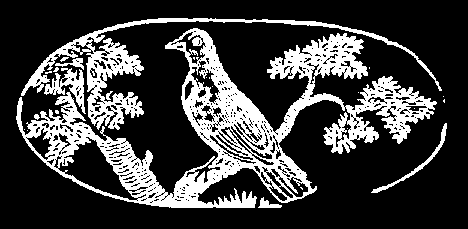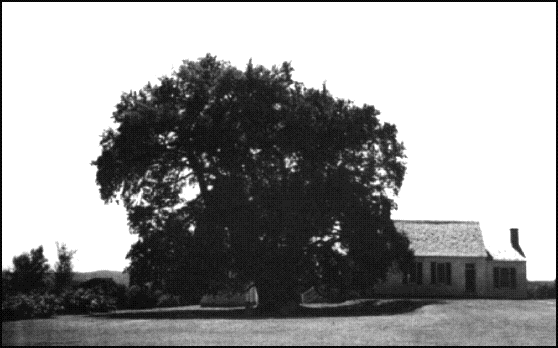
Tropical &
Subtropical
Trees
An Encyclopedia
Margaret Barwick
(Timber Press)

Quick Stick. The Marmalade Box. Shady Lady. Gumbo-Limbo. Panama Canoe. Weeping Ru (not "Roo" --- as in Kanga; not "rue" as in woe ... but "Ru.")The Handkerchief Tree (the leaves do droop) and the Weeping Tea Tree. Then there's the Fried Egg Flower (self-explanatory) and the Poached Egg Tree (no explanation, although it is noted that the blooms "are considered to arouse sexual desire," are used "to fill the pillows of bridal beds.)
The Outrageous Parasol. The Drunkard's Plum on which, it is rumored, elephants "may become intoxicated by overripe, fermenting fruit."
The Vegetable Hummingbird, the flowers of which, in India, are fried, "the red blooms considered superior to the white." The slightly vulgar sounding Poon Tree, whose blooms "have an offensive smell."
The Rain Tree, of Swiss Family Robinson fame, has a "monstrous parasol canopy." The name comes not from the umbrella shape, but from "a curious shower of moisture caused by thousands of tiny insects that suck on tender, juicy new growth. At the same time they exude their bodily fluids [!] that are said to 'fall as a gentle rain' to dampen the ground."
The sheer poetry of the names are so good, in some cases, that you want to eat them. Like the Breadnut. Then, for those who are tired, there's the Tuckeroo; for fans of Jimmy Durante, the Calabash; for Indian lovers, the Lignus Vitæ, for lovers of love, the Naked Lady; for fans of Passage to India, the Malabar Plum.
And for space nuts, we find the Langsat. For rat lovers, the Pamplemousse. For Scrabble fans, the U'a. For lovers of sheer smell: Stinkwood, Stinking Pea, and Stinking Toe --- no explanation for the last, but it is also known as the old Locust Tree. And for those of you who don't like trees at all, there is the Cabbage Bark, otherwise known as Pig's Turd, from the "pebbly, toxic seeds," which, indeed, look a little bit like our least favorite road apple.
For some of us who are fond of mere words, the music of them --- there is the poetry of the names:
- Sapote
- Asoka
- Coleville's Glory
- Capulin
- Chupa-Chupa
- Espuela de Caballera
- Jambu Mawa
- Shishoble, and
- Sapodilla.
Finally, there is the hairy Darwin Woolly-Butt, no explanation, but "limbs are used by Aborigines to make didjeridoos" (also no explanation).
§ § § Ms. Barwick is obviously bonkers about trees, and the writing is sensual and seductive, a style of writing that is appropriate to a love-paean. She tells of the Carob, where the males are "catkin-like, with a pungent smell, and the females are solitary." The fruit is "fleshy ... a sweet, mucilaginous pulp." She tells of John the Baptist's husks "that the swine did eat" --- thus called "St. John's Bread."
"The ripe juicy fruit swollen with sweet mucilage that nourished Wellington's cavalry when they wintered along the north Spanish coast during the Peninsular War between 1808 - 1814."
Perhaps the greatest fame, however, is the claim that its large seeds were the original carat weight used by jewelers and apothecaries. The fruit is fermented to make alcohol and the seeds have been used as a coffee and chocolate substitute, as a coloring for bouillon cubes or as a diabetic flour suitable as a baby food.
"A type of confectionery is derived from the pulp. The heavy red timber is used for furniture. The seeds must be soaked for 24 hours before sowing. This is an important honey plant." Gor, is there nothing she doesn't know about these trees, all trees?
A thousand or so are represented here, with at least five photographs awarded to each --- usually of the plant as a whole, its bark, and the male and female parts. The description is complete with Latin name, country of origin, height, status (both threatened or in some cases, "undesirable"), tolerance for dry climate or salt water, form of propagation, and in which zone --- between the Tropic of Cancer and the Tropic of Capricorn --- the tree is to be found.
§ § § A complaint, but a tiny one. Often the common name is not represented in the exhaustive index. I suspect it is here, but I was not able to find the Castor tree that lives on the north side of my lot, and provides two-foot long pods that crunch under my car wheels. Between the Pakalana and the Palm-Leaf Fig, I could discover none of the palm trees that threaten, when I am lying in their shade, to release their babies and bonk me on the cupola.
I also couldn't locate the stinker of my college days, the Ginko whose berries would litter the walkways, in the spring, and as my love and I crunched them underfoot, they would release a disgusting smell which --- we would assume --- the gentle Ms. Barwick would not care for.
The publishers tell us that the book encompasses 2,305 illustrations, 1,981 in color. At $69.95, that works out of about three cents a shot. Well worth it.

--- George Bell Ball, Jr.